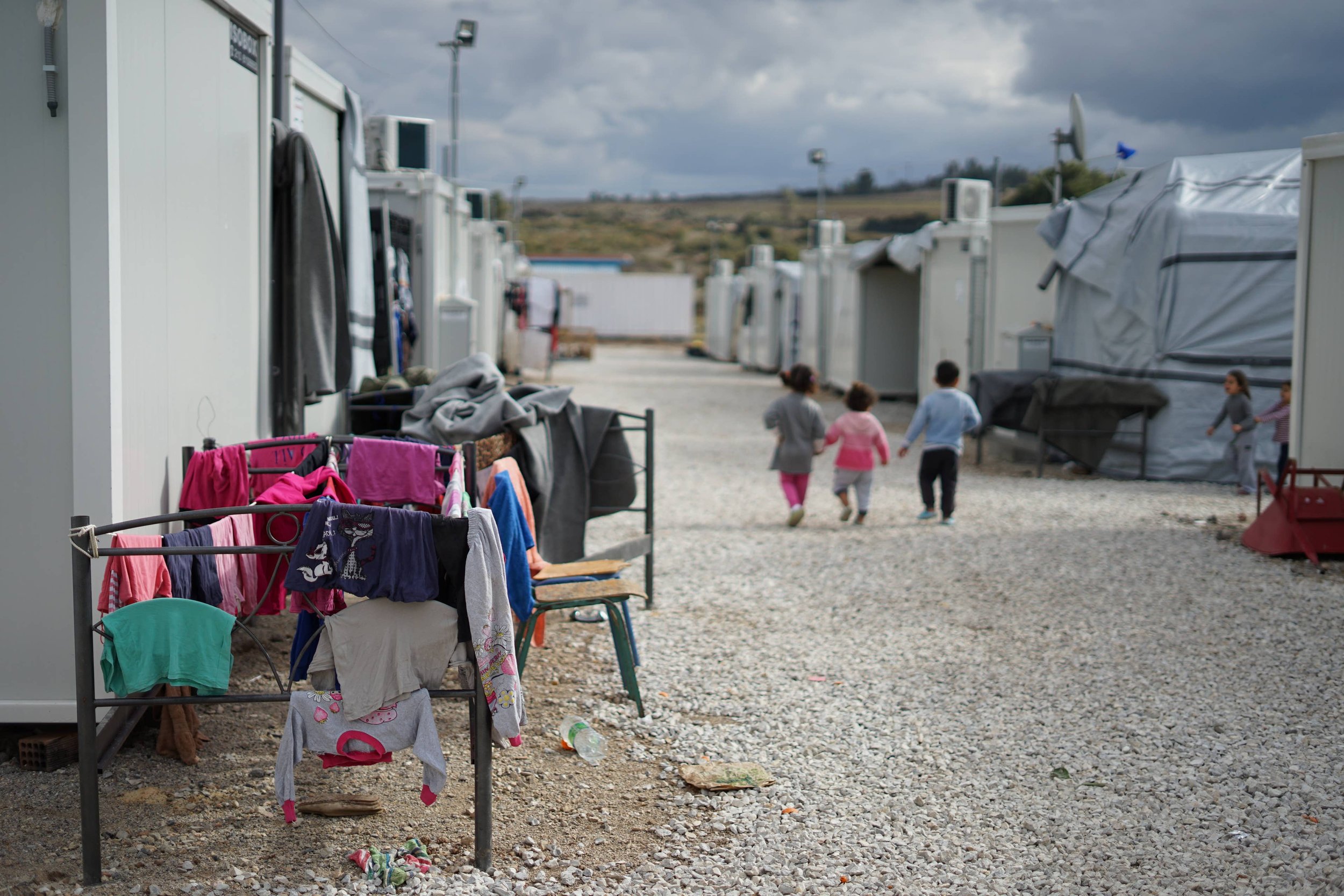
Refugee
Poetry
Project
Add your poems and prayers to the map.
Join this collaborative project to speak hope into the lives of refugees, and all those who are working to help them build a home.
See the tips and resources below to create a simple poem that you can pin to the map as a creative prayer for all displaced people in that part of the world.
Contents:
The Art Gallery
A PICTURE SPEAKS A THOUSAND WORDS.
Click here to view a digital photo gallery that complements this project.
Source: Lost Family Portraits | Victims of War | Everyday Refugees | The Atlantic
INTRODUCTION
A poem for refugees.
There are many kinds of "exiles" in our world. Some of the English students who attend our classes have moved away from their countries and hometowns, and they relate to the feeling of being a "foreigner" in a new land. Spiritually, many of us look at the world around us and we might realize that we're called to be a part of something greater than the broken reality that exists all around us, and in that way, we too relate to this feeling of being an "outsider." There are many who know what it feels like to be an exile, and so these poems are for them.
But there is one specific group we want to focus on for this project: Refugees. Not every refugee is able to acquire the official legal status to be considered a "refugee", but they are still refugees. These poems are for them too: Asylum seekers, internally displaced persons, forced migrants. Citizens of countries that have been plagued by wars and occupations for generations. Families who have lost their homes to hurricanes, floods, wildfires, earthquakes, and other natural disasters.
We want to write a hope-filled poem for refugees. And we want it to capture the heart behind the first few words of this passage from Ephesians 2 (taken out of The Message), which sets the theme for this poetry project:
Take a moment to reflect on Ephesians 2 (you can use whichever translation or language you prefer). Click here to read the full chapter.
This passage addresses some of the heartbreaking aspects felt by society's "exiles" and "outsiders" throughout history—but the passage doesn't end there. It describes what Jesus accomplished by breaking down the walls that existed between different groups of humans, as well as the barrier that existed between mankind and God. The passage also paints a hopeful picture of the "dwelling place" that He is creating with his people. God is building a home, and he's inviting "strangers" like us to be a part of His family!
Therefore, as we begin to create poems inspired by this passage—and God's heart for the exile—these poems may deal in some way with the pain and suffering of refugees. However, it is also important that we look for ways to share perspectives of hope at the same time. God is building a home! And part of what we get to do is welcome people into that new home and invite them into that family.
You're no longer wandering exiles,
you are Citizens of Hope.
This poem is about pain and suffering,
but it is also about finding hope and a home.
The goal for this project is that we would be able to inspire others as we express—through poetry—this dichotomy that exists between "exile" and "home." Between antonyms such as "stranger" and "family." We will start by writing our own individual pieces to this poem, and then we are going to weave those pieces together into a single presentation using the interactive map at the top of this page.
We will walk you through each step of this project next.
Let's go!

PART 1
Create a Diamond Poem
The idea of writing and performing poetry can seem scary, much like other forms of creative writing and public speaking. But what if there was an easy way to get started making poems? A way that took a lot of the pressure off of individuals? We are going to start with a simple and fun way to create poems that adults, children, and even Beginner-level language students will enjoy.
These little poems will also become the starting point for other poems and prayers.
Take a moment to think about the millions of people in the world who are forcibly displaced right now. Click here to view a digital photo gallery that complements this project.
Choose a specific person ("Fatima"), place ("Syria"), or people group ("Mothers") that is on your heart. Ask God how you can pray for them. What words would HE use to describe them?
Write down your thoughts using the diamond-shaped template below. This will create a tiny poem/prayer. (See example)

PART 2
Create a Spoken Word
Want to keep writing? Write down your prayers as a longer poem that can be read aloud as a "spoken word." The goal of this activity is not to become masterful poets, but to expand our poems and prayers as we express what is on God's heart. And—just like we did with the diamond poems—we are going to give you a few simple guidelines to follow.
These Spoken Word poems have three parts:
The first line — represents hopeless situations. Use this fill-in-the-blank sentence to write this line: You're no longer ____________.
The body — is the middle section of the poem. You can say or write anything that is on your heart. Tip: Use the text from your Diamond Poem as a starting point to quickly create a first draft!
The last line — represents the new hopeful places that God is building for those refugees: a family and a home and so much more. Use this fill-in-the-blank sentence to write this line: You are ____________.
Write a first draft.
Tip: Use the text from your Diamond Poem for the body of this poem.Write a second draft.
Expand the poem by adding new words, lines, and punctuation. When you're done: Share your poem by reading it out loud!Keep reading out loud and revising.
How does your poem sound? Keep revising until you are happy with it.
PART 3
How to pin your poem to the map
Now that you're almost done, it's time to share your poems so that everyone can be encouraged by them, and so we all can believe and pray those words out loud together. Teachers, students, leaders, volunteers—many from around the world will read your words and believe in them too. This is a great opportunity for you to speak hope into the lives of refugees, and all those who are working to help them build a home.
These Spoken Word poems have three parts:
Take a photo. — Write your Diamond Poem on a piece of paper. If you want, you can even paint or draw around it to make it look nice. Get started: Click the "+" icon to create a new post, then click the camera icon to snap a quick photo of your poem.
Type your poem. — It only takes a few seconds to type your Spoken Word and post it on the map. Get started: Click the "+" icon to create a new post, then type your poem in the space near the bottom of the post.
Record your poem. — Add your own voice to the map by recording your Spoken Word, or Diamond Poem, or prayer. Get started: Click the "+" icon to create a new post, click the "..." icon, and then select "audio recorder." You can pause and resume recording any number of times, and you can replay your recording before you post it.
Ready? Well then...
Pin it to the map!
Follow these tips, have fun, and be creative.
Click "Publish" when you're done with your post.
Explore the other poems on the map.
And spend some time praying them out loud.
WANT RESOURCES FOR TEACHING ENGLISH THROUGH CREATIVE AND INSPIRING ACTIVITIES LIKE THIS POETRY PROJECT?
Click one of the links below to explore a free preview of these modules. You can explore our chapter about “Using Poetry for Teaching English” when you sign up for Module 3.
-

MODULE 1 | Intro to Learning
This module consists of several lessons related to the topic of learning. Key lessons include: Classroom Values, Icebreaker Activities, Student Needs, Learning Styles, Proficiency Levels, Second Language Acquisition (SLA), Language and Culture.
-

MODULE 2 | Teaching and Lesson Planning
This module features several lessons related to the topic of teaching. Key lessons include: Teaching Methods, Designing Quick-and-Easy Lesson Plans Using PPP, Using Lesson Plan Templates, and Creating Resources For Your Lesson Plans.
-

MODULE 3 | Teaching the Macro Skills
This module features lessons and resources that focus on how to teach the four basic macro skills: Speaking, Listening, Reading, Writing. We will also look at how to teach a number of micro skills: Pronunciation, Literacy, and Grammar.
COURSE EXPLORER
Get special access to the entire Citizens TESOL course for the next few months! Starting at $10 per month.
This is a wonderful way to explore all of our modules and resources — at a reduced price, and for a limited period of time. A good option for language schools, professional teachers, returning students, or those who are just beginning their TESOL journey.

THE ADVENTURE BEGINS HERE »
Course Introduction
ˇ ˇ ˇ
Get amazing video tutorials to complement resources like this!
We are always adding new content in our TESOL course to help teachers bring hope to their communities and their classrooms. Subscribe to our YouTube channel to get our latest videos!
“These are not just language learning activities, and this is not just a language classroom.” — TESOL is about so much more…
In this sample video from our TESOL course, you will hear Andy’s story of a refugee student from Nepal and how that encounter showed him the power of a simple activity in an English class. This is part of a series of videos about Icebreaker Activities, and you can learn more from this topic on page 10 of the Fun Activities for Teaching English resource (above), or by exploring the free preview of Module 1.




































